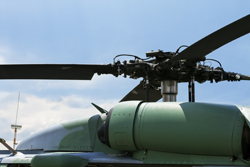Less noise from overhead choppers
Airports are increasingly located near urban areas. Rising awareness of the effects of noise on public health makes it imperative to reduce flight-associated noise emissions. It is also one of the main goals set by the Advisory Council for Aeronautics Research in Europe (ACARE) for 2020. EU-funded scientists working on the project 'Development of helicopter exhaust engine noise reduction technologies' (HEXENOR)(opens in new window) are contributing to this effort by developing three liner concepts to reduce engine noise radiated by the exhaust system.The liner geometry in all cases is a cavity made of partitions above a perforated plate. Acceptable acoustic attenuation is being balanced against mass and cost constraints. The team is working on a short liner made of titanium aluminide (TiAl), a light-weight alloy with mechanical properties adequate for the relatively low-stress environment of the envisioned system. Medium-length and long liners are being constructed from a recently patented ferritic stainless steel (K44X grade), a low-cost material with increased high-temperature resistance suitable for exhaust applications.During the first 15-month period, the team carried out important studies characterising the liner geometry and materials in actual aero-acoustics engine conditions. Experimental and theoretical investigations of the lined barrels (cylindrical duct sections with a wall liner) were carried out. This not only enabled specification of the best liner designs for noise attenuation but also served to fine-tune the analytical models. Scientists have now delivered a preliminary computer-aided design model of the TiAl nozzle that is pending design validation.Despite significant technological advancements, aircraft noise has become an important issue in European urban environments. HEXENOR noise-reduction technologies targeted at minimising radiation of helicopter engine noise through the exhaust system could provide major relief. In addition, the technologies are well-suited to applications in other areas, including pumps, fans and internal combustion engines used in the ventilation and automotive industries.




